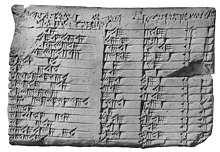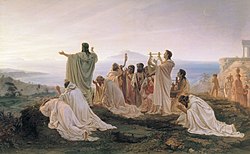Ideas held over the next two centuries by followers of Pythagoras of Samos (6th century BC).
Pythagoras is said to have founded a semi-religious brotherhood which developed doctrines about reincarnation and purification. He is also credited with noticing that simple harmonies (octave, fifth and so on) are associated with simple arithmetical ratios.
He or his followers (who reverently attributed their own ideas to him) developed a metaphysics of limit (good) and unlimited (bad), and in some way saw number as lying at the basis of reality; but the mathematical ideas traditionally attributed to them (including ‘Pythagoras’ theorem’) are now thought unlikely to belong to Pythagoreans earlier than Archytas of Tarentum (fl. 400 BC).
Scientific ideas, such as that the Earth is not at the centre of the universe, may have a Pythagorean origin, but were probably developed for religious rather than scientific reasons.
Also see: Orphism
Source:
J A Philip, Pythagoras and Early Pythagoreanism (1966)
History

The Plimpton 322 tablet records Pythagorean triples from Babylonian times.[1]

Animation demonstrating the simplest Pythagorean triple, 32 + 42 = 52.

Bust of Pythagoras, Musei Capitolini, Rome.
Pythagoras was already in ancient times well known for the mathematical achievement of the Pythagorean theorem.[2] Pythagoras had been credited with discovering that in a right-angled triangle the square of the hypotenuse is equal to the sum of the squares of the other two sides. In ancient times Pythagoras was also noted for his discovery that music had mathematical foundations. Antique sources that credit Pythagoras as the philosopher who first discovered music intervals also credit him as the inventor of the monochord, a straight rod on which a string and a movable bridge could be used to demonstrate the relationship of musical intervals.[3]
Much of the surviving sources on Pythagoras originate with Aristotle and the philosophers of the Peripatetic school, which founded histographical academic traditions such as biography, doxography and the history of science. The surviving 5th century BC sources on Pythagoras and early Pythagoreanism are void of supernatural elements, while surviving 4th century BC sources on Pythagoreas’ teachings introduced legend and fable. Philosophers who discussed Pythagoreanism, such as Anaximander, Andron of Ephesus, Heraclides and Neanthes had access to historical written sources as well as the oral tradition about Pythagoreanism, which by the 4th century BC was in decline. Neopythagorean philosophers, who authored many of the surviving sources on Pythagoreanism, continued the tradition of legend and fantasy.[4]
The earliest surviving ancient source on Pythagoras and his followers is a satire by Xenophanes, on the Pythagorean beliefs on the transmigration of souls.[5] Xenophanes wrote of Pythagoras that:
Once they say that he was passing by when a puppy was being whipped,
And he took pity and said:
“Stop! Do not beat it! For it is the soul of a friend
That I recognized when I heard it giving tongue.”[5]
In a surviving fragment from Heraclitus, Pythagoras and his followers are described as follows:
Pythagoras, the son of Mnesarchus, practised inquiry beyond all other men and selecting of these writings made for himself a wisdom or made a wisdom of his own: a polymathy, an imposture.[6]
Two other surviving fragments of ancient sources on Pythagoras are by Ion of Chios and Empedocles. Both were born in the 490s, after Pythagoras’ death. By that time he was known as a sage and his fame had spread throughout Greece.[7] According to Ion, Pythagoras was:
… distinguished for his many virtue and modesty, even in death has a life which is pleasing to his soul, if Pythagoras the wise truly achieved knowledge and understanding beyond that of all men.[8]
Empedocles described Pythagoras as “a man of surpassing knowledge, master especially of all kinds of wise works, who had acquired the upmost wealth of understanding.”[9] In the 4th century BC the Sophist Alcidamas wrote that Pythagoras was widely honored by Italians.[10]
Today scholars typically distinguish two periods of Pythagoreanism: early-Pythagoreanism, from the 6th till the 5th century BC, and late-Pythagoreanism, from the 4th till the 3rd century BC.[11] The Spartan colony of Taranto in Italy became the home for many practitioners of Pythagoreanism and later for Neopythagorean philosophers. Pythagoras had also lived in Crotone and Metaponto, both were Achaean colonies.[12] Early-Pythagorean sects lived in Croton and throughout Magna Graecia. They espoused to a rigorous life of the intellect and strict rules on diet, clothing and behavior. Their burial rites were tied to their belief in the immortality of the soul.[11]
Early-Pythagorean sects were closed societies and new Pythagoreans were chosen based on merit and discipline. Ancient sources record that early-Pythagoreans underwent a five year initiation period of listening to the teachings (akousmata) in silence. Initiates could through a test become members of the inner circle. However, Pythagoreans could also leave the community if they wished.[13] Iamblichus listed 235 Pythagoreans by name, among them 17 women whom he described as the “most famous” women practitioners of Pythagoreanism. It was customary that family members became Pythagoreans, as Pythagoreanism developed into a philosophic traditions that entailed rules for everyday life and Pythagoreans were bound by secrets. The home of Pythagoras was known as the site of mysteries.[14]
Pythagoras had been born on the island of Samos at around 570 BC and left his homeland at around 530 BC in opposition to the policies of Polycrates. Before settling in Croton, Pythagoras had traveled throughout Egypt and Babylonia. In Croton, Pythagoras established the first Pythagorean community, described as a secret society, and attained political influence. In the early 5th century BC Croton acquired great military and economic importance. Pythagoras emphasized moderation, piety, respect for elders and of the state, and advocated a monogamous family structure. The Croton Council appointed him to official positions. Among others Pythagoras was in charge of education in the city. His influence as political reformer reputably extended to other Greek colonies in southern Italy and in Sicily. Pythagoras died shortly after an arson attack on the Pythagorean meeting place in Croton.[15]
The anti-Pythagorean attacks in c. 508 BC were headed by Cylon of Croton.[15][16] Pythagoras escaped to Metapontium. After these initial attacks and the death of Pythagoras, Pythagorean communities in Croton and elsewhere continued to flourish. At around 450 BC attacks on Pythagorean communities were carried out across Magna Graecia. In Croton, a house where Pythagoreans gathered was set on fire and all but two of the Pythagorean philosophers burned alive. Pythagorean meeting places in other cities were also attacked and philosophic leaders killed. These attacks occurred in the context of widespread violence and destruction in Magna Graecia. Following the political instability in the region, some Pythagorean philosophers fled to mainland Greece while others regrouped in Rhegium. By about 400 BC the majority of Pythagorean philosophers had left Italy. Archytas remained in Italy and ancient sources record that he was visited there by young Plato in the early 4th century BC. The Pythagorean schools and societies died out from the 4th century BC. Pythagorean philosophers continued to practice, albeit no organized communities were established.[15]
According to surviving sources by the Neopythagorean philosopher Nicomachus, Philolaus was the successor of Pythagoras.[17] According to Cicero (de Orat. III 34.139), Philolaus was teacher of Archytas.[18] According to the Neoplatonist philosopher Iamblichus, Archytas in turn became the head of the Pythagorean school about a century after the Pythagoras’ death.[19] Philolaus, Eurytus and Xenophilus are identified by Aristoxenus as the teachers of the last generation of Pythagoreans.[18]
Philosophic traditions
Following Pythagoras’ death, disputes about his teachings led to the development of two philosophical traditions within Pythagoreanism in Italy: akousmatikoi and mathēmatikoi. The practitioners of mathēmatikoi recognized practitioners of akousmatikoi as fellow Pythagoreans, but because the mathēmatikoi allegedly followed the teachings of Hippasus, the akousmatikoi philosophers did not recognise them. Despite this, both groups were regarded by their contemporaries as practitioners of Pythagoreanism.[20]
The akousmatikoi were superseded in the 4th century BC as significant mendicant school of philosophy by the Cynics. Philosophers of the mathēmatikoi were in the 4th century BC absorbed into the Platonic school of Speusippus, Xenocrates and Polemon. As a philosophic tradition, Pythagoreanism was revived in the 1st century BC, giving rise to Neopythagoreanism.[21] The worship of Pythagoras continued in Italy in the two intervening centuries. As a religious community Pythagoreans appear to have survived as part of, or deeply influenced, the Bacchic cults and Orphism.[22]
The akousmatikoi

Pythagoreans celebrate sunrise, 1869 painting by Fyodor Bronnikov.
The practitioners of akousmatikoi believed that humans had to act in appropriate ways. Akousmata (translated as “oral saying”) preserved all sayings of Pythagoras as divine dogma. The akousmatikoi tradition resisted any reinterpretation or philosophic evolution of Pythagoras’ teachings. Individuals who by their actions attained the most akousmata were regarded as wise. The akousmatikoi philosophers refused to recognize that the continuous development of mathematical and scientific research conducted by the mathēmatikoi practitioners was in line with Pythagoras’s intention. Until the demise of Pythagoreanism in the 4th century BC, the akousmatikoi continued to engage in a pious life by practicing silence, dressing simply and avoiding meat, for the purpose of attaining a privileged afterlife. The akousmatikoi engaged deeply in questions of Pythagoras’ moral teachings, concerning matters such as harmony, justice,[23] ritual purity and moral behavior.[24]
The mathēmatikoi

The Archytas curve
The practitioners of mathēmatikoi acknowledged the religious underpinning of Pythagoreanism and engaged in mathēma (translated as “learning” or “studying”) as part of their practice. While their scientific pursuits were largely mathematical, they also promoted other fields of scientific study in which Pythagoras had engaged during his lifetime. A sectarianism developed between the dogmatic akousmatikoi and the mathēmatikoi, who in their intellectual activism became regarded as increasingly progressive. This tension persisted until the 4th century BC, when the philosopher Archytas engaged in advanced mathematics as part of his devotion to Pythagoras’ teachings.[23]
Today, Pythagoras is mostly remembered for his mathematical ideas, and by association with the work early Pythagoreans did in advancing mathematical concepts and theories on harmonic musical intervals, the definition of numbers, proportion and mathematical methods such as arithmetic and geometry. The mathēmatikoi philosophers claimed that numbers were at the heart of everything and constructed a new view of the cosmos. In the mathēmatikoi tradition of Pythagoreanism the Earth was removed from the center of the universe. The mathēmatikoi believed that the Earth, along with other celestial bodies, orbited around a central fire. This, they believed, resembled a celestial harmony.[25]
Rituals
Pythagoreanism was a philosophic tradition as well as a religious practice. As a religious community they relied on oral teachings and worshiped the Pythian Apollo, the oracular god of Delphic Oracle. Pythagoreans preached an austere life.[26] They believed that the soul was buried in the body, which acted as a tomb for the soul in this life.[27] The highest reward a human could attain was for the soul to join in the life of the gods and thus escaped the cycle of reincarnation in another human body.[28] Like the practitioners of Orphism, a religious tradition that developed in parallel to Pythagorean religious practice, Pythagoreanism believed that the soul was buried in the body as a punishment for a committed offense and that the soul could be purified.[29] Aside from conducting their daily lives according to strict rules Pythagorean also engaged in rituals to attain purity.[30] The 4th century Greek historian and sceptic philosopher Hecataeus of Abdera asserted that Pythagoras had been inspired by ancient Egyptian philosophy in his use of ritual regulations and his belief in reincarnation.[2]
Philosophy
Early Pythagoreanism was based on research and the accumulation of knowledge from the books written by other philosophers.[6] Pythagoras’ philosophic teachings made direct reference to the philosophy of Anaximander, Anaximenes of Miletus and Pherecydes of Syros.[6] Of the Pythagorean philosophers, Hippasus, Alcmaeon, Hippon, Archytas and Theodorus, written sources have survived.[31]
Arithmetic and numbers

The first six triangular numbers
Pythagoras in his teachings cultivated mathematics and numbers, engaging in a combination of philosophic theorizing and deductive provable methodology. Numbers were in the Greek world of Pythagoras’ days natural numbers – that is positive integers. But unlike their Greek contemporaries, the Pythagorean philosophers represented numbers graphically, not symbolically through letters. Pythagoreans used dots, also known as psiphi (pebbles), to represent numbers in triangles, squares, rectangles and pentagons. This enabled a visual comprehension of mathematics and allowed for a geometrical exploration of numerical relationships. Pythagorean philosophers investigated the relationship of numbers exhaustively. They defined perfect numbers as those that were equal to the sum of all their divisors. For example: 28 = 1 + 2 + 4 + 7 + 14.[32] The theory of odd and even numbers was central to Pythagorean arithmetic. This distinction was for the Pythagorean philosophers direct and visual, as they arranged triangular dots so that the even and odd numbers successively alternate: 2, 4, 6, … 3, 5, 7, …[33]
Early-Pythagorean philosophers such as Philolaus and Archytas held the conviction that mathematics could help in addressing important philosophical problems.[34] In Pythagoreanism numbers became related to intangible concepts. The one was related to the intellect and being, the two to thought, the number four was related to justice because 2 * 2 = 4 and equally even. A dominant symbolism was awarded to the number three, Pythagoreans believed that the whole world and all things in it are summed up in this number, because end, middle and beginning give the number of the whole. The triad had for Pythagoreans an ethical dimension, as the goodness of each person was believed to be threefold: prudence, drive and good fortune.

TY for the useful info! I wouldnt have found this myself!
Thanks for this interesting post. I will be sure to get the word out about this site 🙂 Excellent post. Cant wait to see the next blog post.
I think this website has some real great information for everyone : D.
I just added your web page to my bookmarks. I really like reading your posts. Thanks!
Hey, thanks for sharing I always look forward to reading your posts one of the few blogs I still follow!
Howdy, i recently thinking id post and let and allow you toyou know your blogs design is really messed up on the K-Melon browser. AnyAnyhowhow keep up the good work.
That is some inspirational stuff. Never knew that opinions could be this varied. Very creative, one of the nicer sites I have seen today. Keep up the great work.